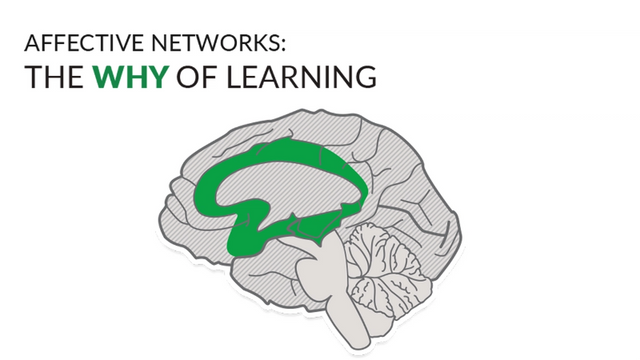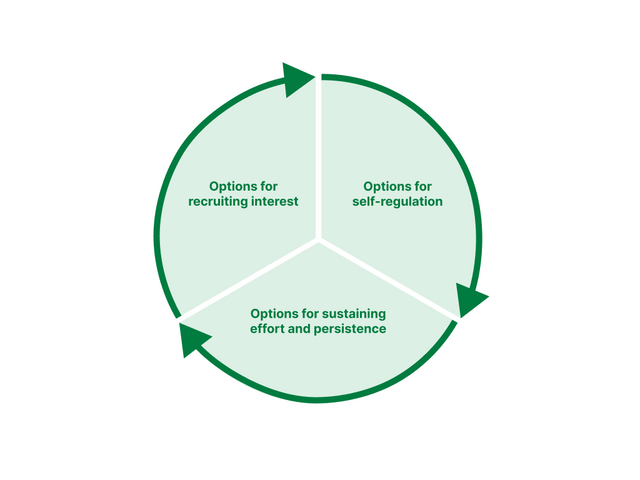Introduction to Multiple Means of Engagement

Critical reflection on my experience as a student in unexciting classrooms enabled me not only to imagine that the classroom could be exciting but that this excitement could coexist with and even stimulate serious intellectual and/or academic engagement.
Learning is a social process. It is supported by positive relationships in the learning environment. Learners need to feel safe and welcomed to fully engage in the learning experience. Learners’ life stories are present with them when they enter learning spaces (and everywhere they go). Creating successful and equitable learning environments means recognizing that every learner has a compelling life story that they will draw on to make connections with the material, with each other, and with the educator. Feeling appreciated and included is fundamental to feeling connected to the learning process and fundamental to learning. This module will focus on the importance of feeling welcomed and included in learning spaces and ways educators can ensure that they are creating an environment where individuals of diverse identities and backgrounds can feel open to share and be their authentic selves.

Inclusion is not bringing people into what already exists; it is making a new space, a better space for everyone.
Let’s take a moment to hear about some strategies educators use to promote a sense of belonging and a welcoming experience for learners in different disciplines.
Professors Desi Di Nardo, Kay Ann Williams, Griffin Epstein and Shelly Mehta share tips for creating inviting spaces for learners through strategies that promote openness for expression, use of digital tools and digital space best practices, and positive interpersonal relationships.
Educator Welcoming Tips
[ Music ]
>> The willingness or forthcomingness for expression is ideal and desirable for any communications class. It is vital learners function and thrive in a zone that is welcoming and accepting of others with cultural values, ideologies, identities, or religion unique from their own. To do that, I strive to create an atmosphere that is familiar and familial. My students have relayed to me, time and time again, that they feel as though we are one big family. The school experience must come to life and should be charged with the vibrancy and dynamism that evokes a camaraderie in which each member feels as if they are part of something bigger than themselves like a collection of tiles in a colourful mosaic. Students are led to feel, we are a COMM family, a community of learners in which mistakes made during class are not frowned upon but crowned upon. They soon realize that erring in class can be a tool for oneself or someone else to benefit from. Albert Hubbard says, "The greatest mistake you can make in life is continually fearing that you'll make one."
[ Music ]
>> Hi. I generally introduce myself and allow students to introduce themselves with the use of maps. So after introducing myself and discussing where I'm from in the Caribbean, I open up the floor asking students, you know, tell me where you're from and let's find it on the map. So basically we can then scroll across the planet. And sometimes we can look at the various areas in China. Sometimes we can look at the various areas in Pakistan or India. Sometimes we can marvel at the long coastline of Vietnam. Sometimes we can look at the difference in size between Iran and Iraq and even the fact that some countries in Europe are landlocked. Other times we can look within Ontario, for example, how far everything is from each other if you wanted to take a drive from Toronto to Montreal, how long it would take us. So these are really, really fun, relaxing icebreaker that I employ at the beginning of my semester. And I find that this really helps in terms of everybody getting to know each other a bit, and we get ready to, you know, work together on our learning journey.
[ Music ]
>> I find it really useful to have a consistent structure for my classes that allows for space and time to check-in and ground ourselves before we begin the collaborative work of learning. When teaching online, I do the same thing every week. So I first let folks know I'll be in the digital space 15 minutes early in case there are things people want to chat about beforehand. As folks come in, I try and greet them in the chat by name. And then I allow for 5 minutes after our start time for folks to get really settled. Once we're all there, I ask folks if there's anything they need to access the space today. I check to see if everyone can hear and see each other and remind folks about the different ways they can participate: in the chat, using their mic, using a shared whiteboard, etcetera. I then make space for announcements folks might want to share, things happening in people's communities that might be relevant to class content, workshops, events, demonstrations they want to invite their classmates to. And then we do a quick go-around. So every week I ask folks to share their names and pronouns if they'd like and give us a word or two to let us know how they're feeling today and that's what we do before we begin the actual content work.
[ Music ]
>> By integrating contemplative pedagogical practices and by attempting to meet students where they're at in terms of their lived experiences and their positionality. I embrace uncomfortable conversations and student resistance because it allows me to encourage continuous self-inquiry and self-reflection. My goal is to create engaging and positive student teacher relationships through regular check-ins, offering and using alternatives to teaching and learning, challenging students, and through representing students' intersectional identities into the curriculum.
[Music]
Educator Welcome Tips - Runtime 4:50 min
https://www.youtube.com/watch?v=tvYJxjH_Pjg
The “Why” of Learning: Our Brain’s Affective Networks
The affective networks of the brain correspond to the UDL principle of Engagement. The parts of our brains that set “values” or priorities, that influence our experience, and that drive our actions, are all located at the very centre of the brain. However, the affective networks do not work alone. They are highly connected with other learning networks like the recognition networks (see Module 3) and the strategic networks (see Module 4).

Affective networks determine the emotional and motivational significance of the world around us. These drive our actions by valuing and prioritizing what we do and learn. The affective networks of the brain correspond to the UDL principle of Engagement.
All learning is built on prior knowledge and experiences. These previous practices and events often drive our interest and engagement. The nervous system constantly makes predictions and anticipates how we will fare in a particular environment or progress towards a particular goal. Acknowledging the variability in learner background knowledge and experience is important for educators, because each learner brings a unique blend of experiences and expectations to each learning event.
The Multiple Means of Engagement principle is concerned with how educators and learners make decisions based on emotions and motivations. It guides the design of learning environments that are open for discussion, are relevant, and support students' self-awareness and their ability to guide themselves through challenges.
This video provides an introduction to the Multiple Means of Engagement principle.
The Multiple Means of Engagement principle is concerned with how we make decisions based on emotions and motivations. It guides the design of learning environments that are safe and relevant and support student resilience, self- awareness, and ability to persist through challenge.
Universal Design for Learning – Introduction to Multiple Means of Engagement
[music]
>> Welcome, everybody. In this video, we're going to focus on the why of learning and the principle called the multiple means of engagement. This principle is focused on the affective neural networks within the brain. While all three principles are interconnected and there is no hierarchy in terms of importance to creating inclusive learning spaces, we begin with engagement because the effective or emotional state of being engaged; and having motivation to learn is the ideal state to begin to perceive and comprehend content; and to be able to act on and express what has been learned.
The UDL framework sees supporting the effective brain networks as the gateway to learning. There are many influences that affect learner variability, including differences in our neurological make-up; our culture; personal relevance; and background knowledge of experiences. In addition, many learners have endured negative experiences with racism, homophobia, transphobia or ableism and carry that trauma, uncertainty and fear into the learning environment. All individuals differ markedly in the ways in which they connect emotionally; derive purpose; experience autonomy; and are willing to persist through challenge while learning. There's not one single method or strategy that will respond to this diversity.
Keeping learners engaged means they're provided with multiple ways to partake in learning; helping them to personally identify why they are learning something. The multiple means of engagement principle is concerned with how we make decisions based on emotions and motivations. It guides the design of learning environments that are safe, relevant and support student resilience, self- awareness and ability to persist through challenge.
The first guideline level is access. So moving from left to right on the access level, we come to the guideline of recruiting interest in the engagement principle. The guideline of recruiting interest is about optimizing choice; ensuring relevance and authenticity; and by minimizing threats and distractions. Offering learners choices in how they engage and share their thoughts and ideas can help develop self-determination, pride in accomplishment and increase the degree to which they feel connected to their learning. To empower learners to take charge of their own learning, involve learners where and whenever possible in setting their own personal academic goals in the course. Designing activities so that learning outcomes are authentic and communicated to real audiences helps learners to reflect on the purpose of what they're learning and the relevance to their own lived experience. When we reduce distractions and stressors for learners, we create the optimal instructional environment which are safer spaces in which learning can occur.
Following the guidelines of recruiting interest is the build level. This guideline of sustaining effort and persistence is about supporting learners who differ in ability to tackle challenges with focus and determination. Many kinds of learning, particularly the learning of new skills and strategies, requires sustained attention and effort. When motivated to do so, many learners can regulate their attention and affect to sustain the effort and concentration required for learning. However, learners differ considerably in their ability to self-regulate in this way. It is upon the educator to support learners to set a vision for their goals and connect to why it matters for them personally. Differentiate the degree of difficulty or complexity within which core activities can be completed. Foster a collaborative learning environment and help learners focus on the process of learning by coaching them to reflect on the trial and error of testing of strategies and tools.
When we move along to the internalized level, we see the guideline of self-regulation which is about fostering learners’ ability to strategically modulate emotional reactions or states to be more effective at coping and engaging with the environment. Learners need to be able to set personal goals that can be realistically reached as well as foster positive beliefs that their goals can be met. However, learners come into learning spaces with varying skills in managing frustration and stressors when they are in the process of meeting their goals. Educators can help learners understand how stress impacts learning, both positively and negatively. And can provide multiple options which can help them stay motivated through challenge. Some of the ways to incorporate the nurturing of self-regulation skills while learning is to help inspire confidence and ownership of learning. Provide strategies to manage healthy emotional responses and interactions. And increase awareness around progress toward goals and how to learn from mistakes.
In this principle, the ultimate goal is a fostering expert learning. That is multiple means of engagement focuses on the goal of becoming a purposeful and motivated learner. The guidelines provide the scaffolding of skills that assist learners to discover their personal strategies that connect them to their learning in meaningful ways so that they can optimize motivation, self-determination and thus feel more engaged.
[music]
Introduction to Multiple Means of Engagement - Runtime 5:55 min
https://youtu.be/TRQy28WHIBw
The Multiple Means of Engagement principle consists of three main guidelines:
- options for recruiting interest,
- options for sustaining effort and persistence, and
- options for self-regulation.
